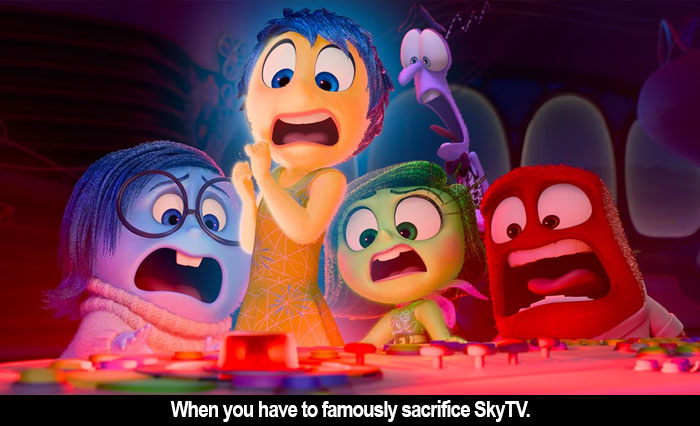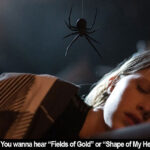*/****
screenplay by Meg LeFauve and Dave Holstein
directed by Kelsey Mann
by Walter Chaw Inside Out 2 hasn’t resolved any of the issues I had with the first film, which boil down to if I’m meant to treat this conceit seriously, then you should probably treat it seriously, too. I grew up with Judy Blume and can’t recall a single instance in her books where a young girl’s emotional development was a playground for cheap gags and high concepts. The sequel’s plot is inane, of course: Riley (voice of Kensington Tallman) goes into puberty around the time of summer hockey camp and experiences the complexities of self-doubt, self-loathing, and anxiety attendant to adolescence. All her thoughts and actions are retrofitted around the decisions made by a cadre of anthropomorphized emotions as they battle for supremacy over a TARDIS-like control centre located somewhere, it seems, in Riley’s frontal cortex. The stakes are elevated because Riley is a vulnerable young woman, not because she’s an especially well-developed character. Because she’s blonde, blue-eyed, and adorable, every little thing that doesn’t go well for her is cause for people raised in this culture to tsk and worry. I would go so far as to say the stakes are outsized for what this is, i.e., a nonce of a nothing-burger, precisely because we are hardwired to cherish this species of porcelain vessel independent of any personal knowledge of her. She is a pinnacle of a cultural ideal, and if she is troubled, we are troubled.
Consider this premise if it were an animated retrofit of a serial killer, how interesting it might be to conjure the cocktail of stock emotions resulting in the need to murder young women who look like Riley. We wouldn’t immediately empathize with the focus of every character’s intentions. It wouldn’t just be Anger, right? We would now have things like “Desire” and “Resentment.” What does abuse look like in this scenario? Inside Out 2 sees it as a ball of a bad memory the “consciousness” shuttles into a multicoloured pit at the bottom of a translucent intestinal chute–but doesn’t abuse cause perception to twist and, with it, emotional response? It would have to be lots of ideas working together, including the giant monster “Big Secret” Inside Out 2 teases in Riley’s unconscious that turns down the opportunity to escape with a sepulchral “NOT YET!” before locking itself back in a massive Jungian repression vault. Is this film suggesting there is a “BigBad” in Riley’s life that will manifest itself in another sequel if this franchise becomes Pixar’s answer to Antoine Doinel? Between the previous film and this one, Riley’s already had a dissociative nervous breakdown and what appears to be a massive, paralyzing anxiety attack, so I guess I wouldn’t be all that surprised to discover she was severely traumatized by an event so foul she’s buried it deep. I know it’s a joke. I would like you to consider the nature of the joke. Fair is fair.
I would also like to consider the joke the manifestation of Joy (Amy Poehler) makes about the name of new emotion “Ennui” (Adèle Exarchopoulos)–how she has trouble pronouncing “on-wee” and settles on “Wee Wee” as an acceptable substitute. She’s not reading the word, she’s repeating it. I believe Joy is being a bully here because the nature of this universe and the writing level of its dialogue would suggest to me that she is capable of pronouncing “on-wee” and, more, has done so not infrequently. If it’s not bullying, it’s certainly behaviour I recognize from an entire childhood spent in dread of white people pretending to want to learn how to pronounce my Chinese name. I think Joy is the villain of these films: a representation of how toxic “joy” can be when forced upon others, like when she tells everyone to “look at Embarrassment!” (Embarrassment being another new addition voiced by Paul Walter Hauser.) Young viewers who are empathetic will cringe at her invitation–which is, again, bullying, ugly behaviour. It’s hard to root for Joy unless you’ve been desensitized to this kind of emotional conditioning. The ultimate lesson of the first film is that every emotion is essential in the development of a person, especially if it’s Joy. The ultimate lesson of the second film, carefully spelled out by an extended epilogue, is that Riley is a complicated mess of contradictions redeemed by Joy. I find both messages simplistic and potentially dangerous. If it’s no revelation that Joy is the bad guy here, then I wonder at the wisdom of making her quest to regain control of Riley once Anxiety (Maya Hawke) commandeers Riley’s Ego/Id the thing we root for in Inside Out 2. Moreover, I question the ethics of making a movie about the emotions of a young girl that casts her as an automaton at the mercy of sentient hormones while she herself hovers somewhere as a never-seen/never-felt “SuperEgo.”
What happens is that Joy and her buddies Sadness (Phyllis Smith), Fear (Tony Hale), Disgust (Liza Lapira), and Anger (Lewis Black) are “bottled up” (literally, in a big mason jar) by Anxiety, Embarrassment, Ennui, and Envy (Ayo Edibiri) as Riley evolves into a sketch-comedy teen (acting CRAZY and needing deodorant) from her default sketch-comedy pre-teen stereotype (having giant, wet eyes like a Miyazaki lemur). The movie treads water with a few cheap gags about how emotional tweens are until it introduces an exhausted summer-camp scenario where Riley wants to impress another hockey-playing girl while ignoring her suddenly less-cool friends. If you’re thinking these ingredients lead to a Sapphic awakening over a magical Summer of ’69, no, they don’t. Inside Out 2 doesn’t do anything except portray “Herman’s Head” antics that translate into brief “real-world” reactions to said antics. Imagine Ratatouille if instead of just the one rat under the hat marionetting a would-be chef, there were eight. I don’t think it would be eight times better. Now imagine if instead of a full-grown man, the puppet was an extremely vulnerable child who has already had two psychological breakdowns and, lest we forget, is promised another humdinger of a collapse somewhere down the line. “We all love our girl!” squeals Joy at a couple of key moments; is Riley a separate entity from these emotions, or is she the combination of these entities so that Joy is referring, in an extraordinarily disorienting way, to her fellow emotions as though they were at the service of a separate consciousness?
Anyway, I doubt either Inside Out or Inside Out 2 will suffer any real cosmological analysis since it’s a soap opera…cynically? Yes, cynically centred on a child’s early development. It hasn’t been built for dissection. It doesn’t erect a coherent world and doesn’t offer rules you can follow; it’s a straight line disguised by a lot of prancing-about, and there’s nothing complicated about it. Nothing complicated, that is, except that its subject is a child to whom we have sutured, and her mental health is being played as a power struggle between Anxiety and Joy. Joy calms Anxiety, it says. Sadness and Embarrassment are confederates, too. Ennui loses it when she loses her cellphone, suggesting that Ennui is a state of mind manufactured by screen addiction–so did it exist prior to the cellphone? Or is it just addiction of any type? Don’t ask, this is a movie for children. But why is it that Riley’s Anger is male while her mother’s Anger is female? Does it matter? And what do we make of the scabs who stepped after Bill Hader and Mindy Kaling refused to work for significantly less than Poehler, which highlights the gulf between the haves and have-nots even amongst our culture’s perceived “haves” in the immediate aftermath of Hollywood labour strikes? What are the things we’re not supposed to think about in order to enjoy Inside Out 2? And when does pretending something doesn’t bother you reach the point where it doesn’t bother you? Is losing curiosity and the ability to be bothered like that ringing in your ears when you kill a level of sound you’ll never hear again? I am experiencing Despair. Someone get Richard Lewis’s estate on the line. I need his voice for something.




